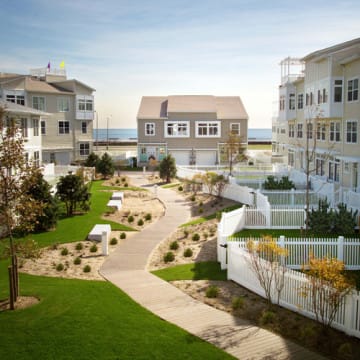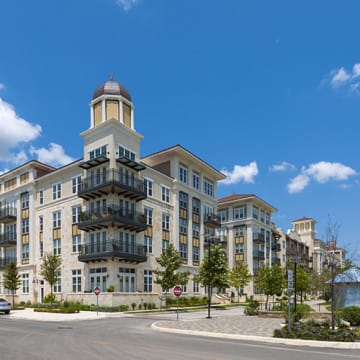Stonebrook Estates
Stonebrook Estates is a 51.4-acre, single-family residential, low-impact development located north of Houston in Harris County. The 135-lot community, currently made up of about 70 completed homes averaging sale prices upward of $500,000 each, offers an example of a hybrid stormwater management system that uses both natural drainage systems and traditional storm sewers to effectively convey stormwater around and away from homes. In addition to adding green amenities to the community, the investment in low-impact development has ensured avoided losses by proving to effectively handle the Tax Day and Memorial Day floods of 2016.
Context
Adopted in 2011, Harris County’s Low Impact Development and Green Infrastructure (LID/GI) Design Criteria provide detailed guidelines and requirements that enable real estate development projects using LID/GI techniques to obtain development permits in the unincorporated portions of the county. Stonebrook Estates was among the first in the Houston area to implement LID principles.
Stonebrook Estates developer Terra Visions LLC could have managed drainage on the site by using a six- to seven-acre detention pond, but instead chose to pursue the LID techniques as part of the overall amenity offering for the development. The development entry features a green, landscaped drainage corridor designed to serve as a gateway to the homes. LID features also provide residents with more green space, a trail system, and a water feature that naturally guides stormwater to two 50-foot-wide detention channels that then filter the flows to an interior detention basin. The basin manages the release of water at a rate and quality that is safe for the surrounding environment.
Innovative Water Management Features
- Natural drainage system. The natural drainage system at Stonebrook mimics the natural flow of water across a green landscape, directing stormwater into linear and lake-style detention basins; from there, stormwater is slowly released to nearby channels and bayous.
- Engineered soils. The first inch of stormwater runoff from the development is routed through engineered soil filters that remove pollutants from the runoff and ensure that the development complies with local post construction stormwater quality management regulations. The engineered soil filters (known as biofiltration) are designed to provide a very high filtration rate, thus avoiding surface ponding.
- Curb cuts and false-back inlets. Roadways are sloped and use “false-back inlets” on the curbs to drain stormwater into bioswales instead of traditional precast concrete storm sewer pipes.
Value Proposition
Randy Jones, Terra Visions LLC principal, describes the LID features as a key part of the development’s sense of place. After Houston’s 2014 downturn caused by falling oil prices, the developer worried the homes would be priced too high for the market. However, although sales volume and absorption were initially lower, the development fared well, with average home prices about 25 percent higher than expected. Jones describes the community as a “complete blend” that was attractive to the suburban Houston market. “It’s on a private street, a gated neighborhood, and well landscaped with LID components right at the front door. When you put all the pieces together, the market likes it,” he explains.
“We could have put a six- to seven-acre detention pond on the far side of the development and gone off without thinking about using the drainage system as an amenity. But the idea was to be different. We chose to use the facility as landscaping and give it a look that’s not an ugly ditch.” Randy Jones, Principal, Terra Visions LLC
The site engineer, Michael Bloom with R.G. Miller Engineers, estimates that the natural drainage system, which is used only in a portion of the development, reduced the site detention requirement by 24 percent, which increased lot yield.
Stonebrook’s natural drainage system was put to the test during the Tax Day Flood of April 2016. Stonebrook received approximately 12 inches of rainfall in a 24-hour period, which is about equal to the 100-year rainfall for the area. The stormwater management system at Stonebrook “functioned better than anticipated given the rain storm intensity,” says Jones. “I was absolutely amazed that the stormwater stayed in the system and didn’t flow into the streets or yards.” The natural drainage system was able to capture then convey the rainfall and runoff, and both the linear and lake-style detention basins successfully released the design flow to the nearby channels and bayous.
Lessons Learned
- A low-impact development framework presents an opportunity to fulfill market demand for environmentally friendly communities. LID principles inherently include natural amenities that are attractive to homeowners, such as trail systems and open space. Jones described green infrastructure as a key component of a well-rounded community desirable to home buyers.
- Natural drainage systems can cut costs of drainage facilities. Stonebrook Estates’ drainage corridor is part of the landscape of the community—and is a more cost-effective alternative for the community’s utilities, given the limited access to the drainage piping system.
- Green infrastructure can mitigate risk and avoid losses. Stonebrook Estates has already survived a major storm, the Tax Day Flood. Infrastructure in this community has proven to be resilient and protected its community members.


